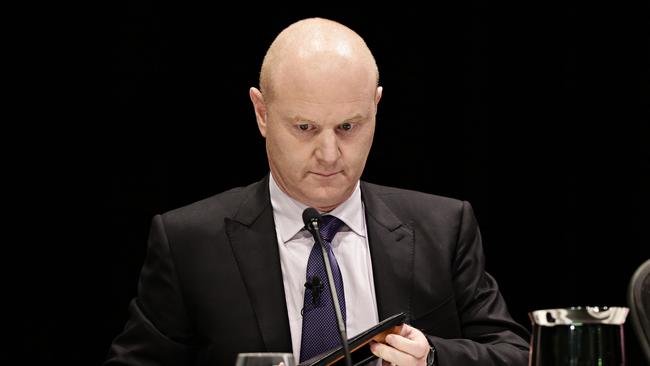Headline figures conceal CBA’s second-half slog

CBA’s annual cash earnings were up a modest three per cent. In the June half, however, earnings actually fell three per cent relative to the December half-year. Flat-lining income, flat net income margins and a sharp increase in impairment charges combined to end an era of solid growth for the bank.
The group’s return on an equity base inflated by last year’s regulator-induced $5.1bn equity raising slumped from 18.2 per cent in 2014-15 to 16.5 per cent in the latest financial year. In the second half the ROE was 15.6 per cent.
The core of the group’s earnings — and the focus of the controversies about the banks’ responses to the RBA’s 25 basis point rate cut — is its retail bank. It increased cash earnings 11 per cent for the year, to $4.4bn, but June half-earnings of $2.2bn were the same as the December half’s $2.2bn.
That’s despite the mortgage “repricing” that occurred last year after the Australian Prudential Regulation Authority foreshadowed the introduction of a floor under mortgage risk-weightings and forced the major banks to raise more than $20bn of new equity.
It was a similar story in CBA’s business banking performance, with full-year earnings up five per cent but the June half, relative to the December half, down five per cent.
That’s a reflection of the intense competition occurring for the relatively low levels of growth in demand for credit and the flow-on effects of the low interest rate environment to the cost of deposits and to the earnings generated on non-interest-bearing cash balances.
More broadly, with competition for the pool of demand for home and business loans and customer deposits increasing and banks required to hold more low-returning capital and more deposit funding, bank margins and earnings are and will remain under pressure.
It isn’t helping that the cycle of historically low levels of bad and doubtful debt charges appears to have turned quite sharply, albeit off a low base. CBA’s impairment expenses were up 27 per cent, to $1.26bn, for the year.
The weakening earnings trajectory came despite a strong performance on costs, with the group’s cost-to-income ratio down a consistent 40 basis points, to 42.4 per cent, across the year.
While CBA didn’t address the controversy over its response to the RBA decision directly in its formal presentations, it did produce a slide with a pointed heading: “Depositors and shareholders fund our lending to borrowers.’’
As with most of the banks, CBA, while cutting its standard variable mortgage rates by 13 basis points, lifted its term deposit rates. For some reason, politicians and others are fixated with mortgages, disregarding the interests and claims — and needs — of other bank stakeholders.
CBA is 66 per cent funded by $518bn of customer deposits and has more than $60bn of shareholder capital. It has 11.3m deposit customers and more than 800,000 shareholders — and 1.9m home loan customers.
To be able to fund their lending, the banks have to be able to attract and retain deposits and shareholder capital in an environment where regulators are forcing the banks to hold a lot more of both and where the global ultra-low rate environment is greatly benefiting borrowers but punishing depositors and squeezing bank profitability.
CBA’s common equity tier one capital ratio of 10.6 per cent (or 14.4 per cent on an internationally comparable basis), which was up 150 basis points over the year, makes it one of the best-capitalised banks in the world.
CBA, now the biggest taxpayer in the country, will pay out $7bn of dividends — 76.5 per cent of its profit — to (because of the dividend imputation system) mainly Australian individual and super fund shareholders. Had it passed on the RBA’s rate cut fully to both home loan customers and depositors, it would have been the depositors and shareholders whose interests would have been harmed.
Speaking at a media conference later in the day, Ian Narev provided some useful statistics. About 75 per cent of CBA’s deposit customers are more than 55 years old and between 15 per cent and 20 per cent of the deposits are held for small business customers.
While the increase in deposit rates that followed the RBA move will take time to flow through given the nature of term deposits, based on past experience more than $1 billion a week of deposits would be re-priced.
Australians had $100 billion invested in the bank, directly or via their super funds, and would receive $6 billion of dividends from it this year.
His comments provide meat on the bones of the argument that mortgage holders aren’t the only group in the community affected by movements in interest rates.
Those with mortgages have already experienced a substantial benefit from the big reduction in home loan rates.
Those with savings, until this month, had mainly only seen reduced income. Most of CBA’s 800,000 shareholders are Australians, relying on the bank’s dividends -- $6 billion of the $7 billion of annual dividends flow to Australian shareholders -- to either help fund their retirement or build their savings in advance of it.
Those calling for a royal commission into banking because they regard the banks as greedy for not treating home loan customers as their only constituents should perhaps read some basic primers on post-crisis banking before embarking on that unnecessary and costly exercise. Malcolm Turnbull’s counter, an annual trek to Canberra by the bank CEOs, will at least cost less.
The outlook for the economy, and bank profitability, isn’t bullish and is unlikely to attract quite so much debate about bank greed and profiteering in future as it has in the past.
The RBA’s reduction in the cash rate, to an historically low 1.5 per cent — and market expectations that it will be lowered further — sends its own signal about how the central bank views the economic prospects.
CBA referred to weak income growth and global and domestic political uncertainty as influences generating consumer and business caution and hesitancy in responding to the RBA’s monetary stimulus.
With the bad debt cycle swinging back up towards more normal levels, weak demand for credit, intensifying competition and the still-rising tide of new bank capital and funding regulation, CBA’s second-half performance may be a better indicator of its future than the meagre three per cent annual growth rate, or the big headline number that its critics will no doubt highlight.




Given the faux controversy over bank profitability after banks failed to pass on the entirety of this month’s Reserve Bank rate cut to mortgages, the Commonwealth Bank’s $9.45 billion profit will inevitably spark more bank-bashing. As usual, however, the devil is in the detail and particularly the detail of the second half.